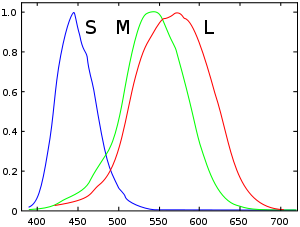
Imaginary color
Encyclopedia

Color space
A color model is an abstract mathematical model describing the way colors can be represented as tuples of numbers, typically as three or four values or color components...
that correspond to combinations of cone cell
Cone cell
Cone cells, or cones, are photoreceptor cells in the retina of the eye that are responsible for color vision; they function best in relatively bright light, as opposed to rod cells that work better in dim light. If the retina is exposed to an intense visual stimulus, a negative afterimage will be...
responses that cannot be produced by any physical (non-negative) light spectrum. Thus, no object can have an imaginary color, and imaginary colors cannot be seen under normal circumstances. Nevertheless, they are useful as mathematical abstractions for defining color space
Color space
A color model is an abstract mathematical model describing the way colors can be represented as tuples of numbers, typically as three or four values or color components...
s.
The spectral sensitivity
Spectral sensitivity
Spectral sensitivity is the relative efficiency of detection, of light or other signal, as a function of the frequency or wavelength of the signal....
curve of medium-wavelength ("M") cone cells overlaps those of both short-wavelength ("S") and long-wavelength ("L") cone cells. Light of any wavelength
Wavelength
In physics, the wavelength of a sinusoidal wave is the spatial period of the wave—the distance over which the wave's shape repeats.It is usually determined by considering the distance between consecutive corresponding points of the same phase, such as crests, troughs, or zero crossings, and is a...
that interacts with M cones also interacts with S or L cones, or both, to some extent. Therefore, there is no wavelength, and no non-negative spectral power distribution
Spectral power distribution
In color science and radiometry, a spectral power distribution describes the power per unit area per unit wavelength of an illumination , or more generally, the per-wavelength contribution to any radiometric quantity .Mathematically, for the spectral...
, that excites only M cones without exciting S or L cones at all. The hypothetical excitation of the M cone alone would correspond to an imaginary color greener than any physical green, corresponding to a spectral power distribution with positive power in the green (medium) wavelengths and (non-physical) negative power in the red and blue (long and short) wavelengths.
Concept and utility
Real colors are colors that can be produced by a physical light source. Any additive mixtureAdditive color
An additive color model involves light emitted directly from a source or illuminant of some sort. The additive reproduction process usually uses red, green and blue light to produce the other colors. Combining one of these additive primary colors with another in equal amounts produces the...
of two real colors is also a real color. When colors are displayed in the CIE 1931 XYZ color space
CIE 1931 color space
In the study of color perception, one of the first mathematically defined color spaces is the CIE 1931 XYZ color space, created by the International Commission on Illumination in 1931....
, additive mixture results in a color along the line between the colors being mixed. By mixing any three colors, one can therefore create colors in the triangle between the three colors—this is called the gamut
Gamut
In color reproduction, including computer graphics and photography, the gamut, or color gamut , is a certain complete subset of colors. The most common usage refers to the subset of colors which can be accurately represented in a given circumstance, such as within a given color space or by a...
formed by those three colors, which are called primary color
Primary color
Primary colors are sets of colors that can be combined to make a useful range of colors. For human applications, three primary colors are usually used, since human color vision is trichromatic....
s. Any colors outside of this triangle can not be obtained.
When defining primaries, the goal is often to leave as many real colors in gamut as possible. Since the region of real colors is not a triangle (see illustration), it is not possible to pick three real colors that span the whole region. It is possible to increase the gamut by selecting more than three real primary colors, but since the region of real colors is not a polygon, there always will be some colors at the edge left out. Therefore, one selects colors outside of the region of real colors as primary colors; in other words, imaginary primary colors. Mathematically, the gamut created in this way contains so-called "imaginary colors".
Perception of imaginary colors
If a saturated green is viewed until the green receptors are fatigued and then a saturated red is viewed, a perception of red more intense than pure spectral red can be experienced. This is due to the fatigue of the green receptors and the resulting lack of their ability to desaturate the perceptual response to the output of the red receptors.At Walt Disney World, Kodak
Eastman Kodak
Eastman Kodak Company is a multinational imaging and photographic equipment, materials and services company headquarted in Rochester, New York, United States. It was founded by George Eastman in 1892....
engineered Epcot
Epcot
Epcot is a theme park in the Walt Disney World Resort, located near Orlando, Florida. The park is dedicated to the celebration of human achievement, namely international culture and technological innovation. The second park built at the resort, it opened on October 1, 1982 and was initially named...
's pavement to be a certain hue of pink so that the grass would look greener.

